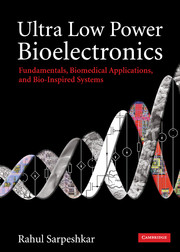Book contents
- Frontmatter
- Contents
- Acknowledgements
- Section I Foundations
- Section II Low-power analog and biomedical circuits
- Section III Low-power RF and energy-harvesting circuits for biomedical systems
- 16 Wireless inductive power links for medical implants
- 17 Energy-harvesting RF antenna power links
- 18 Low-power RF telemetry in biomedical implants
- Section IV Biomedical electronic systems
- Section V Principles for ultra-low-power analog and digital design
- Section VI Bio-inspired systems
- Section VII Energy sources
- Bibliography
- Index
- Epilogue
- References
18 - Low-power RF telemetry in biomedical implants
from Section III - Low-power RF and energy-harvesting circuits for biomedical systems
Published online by Cambridge University Press: 02 December 2010
- Frontmatter
- Contents
- Acknowledgements
- Section I Foundations
- Section II Low-power analog and biomedical circuits
- Section III Low-power RF and energy-harvesting circuits for biomedical systems
- 16 Wireless inductive power links for medical implants
- 17 Energy-harvesting RF antenna power links
- 18 Low-power RF telemetry in biomedical implants
- Section IV Biomedical electronic systems
- Section V Principles for ultra-low-power analog and digital design
- Section VI Bio-inspired systems
- Section VII Energy sources
- Bibliography
- Index
- Epilogue
- References
Summary
I could never accept findings based almost exclusively on mathematics. It ain't ignorance that causes all the trouble in this world. It's the things people know that ain't so.
Edwin ArmstrongBiomedical implants such as cochlear implants, retinal implants, brain implants, cardiac pacemakers, implanted defibrillators, and electronic pills require information to be wirelessly communicated from outside the body to inside the body and vice versa. Wired links from an external electronic unit to an implanted unit inside the body are prone to infection in the long term and are thus unlikely to meet approval by regulatory agencies such as the Food and Drug Administration (FDA). Thus, wireless communication is essential in such implants. in Chapter 16, we discussed how to wirelessly transmit power to such implants via an RF inductive near-field link. Near-field communication is important when the distance of communication, often 1 mm to 10 mm across the skin of the patient, is considerably less than the RF carrier wavelength. In contrast, in far-field communication systems used in most traditional radios, the communication distance is significantly in excess of the carrier wavelength. The relationship between near-field and far-field communication is discussed in quantitative depth in Chapter 17 on antennas and RF energy harvesting.
In this chapter, we shall first focus on how to communicate data via ultra-low-power near-field RF telemetry in such implants.
Information
- Type
- Chapter
- Information
- Ultra Low Power BioelectronicsFundamentals, Biomedical Applications, and Bio-Inspired Systems, pp. 489 - 528Publisher: Cambridge University PressPrint publication year: 2010
References
Accessibility standard: Unknown
Why this information is here
This section outlines the accessibility features of this content - including support for screen readers, full keyboard navigation and high-contrast display options. This may not be relevant for you.Accessibility Information
- 1
- Cited by
